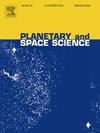M 型小行星的对冲效应
IF 1.7
4区 物理与天体物理
Q3 ASTRONOMY & ASTROPHYSICS
引用次数: 0
摘要
我们提出了观测项目的结果,致力于寻找m型小行星对冲效应行为的可能多样性。新的BVR观测得到了10颗小行星,(325)Heidelberga, (382) Dodona, (558) Carmen, (639) Latona, (758) Mancunia, (789) Lena, (1046) Edwin, (1352) Wawel, (2582) Harimaya-Bashi和(5615)Iskander。其中5颗小行星的直径在5到40公里之间。对于所有观测到的小行星,我们获得了宽相位角范围内的光曲线和星等相位曲线。我们确定了这些小行星的自转周期和绝对星等的值。利用我们的新数据,我们将测量到冲日效应的m型小行星的数量增加了一倍,并首次观测到直径小于40公里的m型小行星的冲日效应。我们发现(558)Carmen、(789)Lena和(5615)Iskander这3颗小行星与其他测量的M型和s型小行星相比,表现出较低的对日效应,但相位曲线线性部分的斜率是中等反照率表面的典型特征。它们的对日效应较低的一个可能解释是,与其他小行星相比,它们表面的金属含量更高。本文章由计算机程序翻译,如有差异,请以英文原文为准。
Opposition effect of M-type asteroids
We present results of the observational program dedicated to search for possible diversity in opposition effect behavior of M-type asteroids. New photometric BVR observations were obtained for 10 asteroids, (325) Heidelberga, (382) Dodona, (558) Carmen, (639) Latona, (758) Mancunia, (789) Lena, (1046) Edwin, (1352) Wawel, (2582) Harimaya-Bashi, and (5615) Iskander. Five of these asteroids have diameters in the range from 5 to 40 km. For all of observed asteroids, we obtained lightcurves and magnitude-phase curves in a wide range of phase angles. We determined values of rotation periods and absolute magnitudes of these asteroids. With our new data, we doubled the number of M-type asteroids with measured opposition effect and for the first time observed opposition effect of M-type asteroids less than 40 km in diameter. We found that three asteroids, (558) Carmen, (789) Lena and (5615) Iskander, exhibit lower values of opposition effect compared to other measured M- and S-type asteroids but the slope of the linear part of the phase curve is typical for moderate-albedo surfaces. A possible explanation of their lower opposition effect is an assumption of a higher metal content on their surfaces as compared to other asteroids.
求助全文
通过发布文献求助,成功后即可免费获取论文全文。
去求助
来源期刊

Planetary and Space Science
地学天文-天文与天体物理
CiteScore
5.40
自引率
4.20%
发文量
126
审稿时长
15 weeks
期刊介绍:
Planetary and Space Science publishes original articles as well as short communications (letters). Ground-based and space-borne instrumentation and laboratory simulation of solar system processes are included. The following fields of planetary and solar system research are covered:
• Celestial mechanics, including dynamical evolution of the solar system, gravitational captures and resonances, relativistic effects, tracking and dynamics
• Cosmochemistry and origin, including all aspects of the formation and initial physical and chemical evolution of the solar system
• Terrestrial planets and satellites, including the physics of the interiors, geology and morphology of the surfaces, tectonics, mineralogy and dating
• Outer planets and satellites, including formation and evolution, remote sensing at all wavelengths and in situ measurements
• Planetary atmospheres, including formation and evolution, circulation and meteorology, boundary layers, remote sensing and laboratory simulation
• Planetary magnetospheres and ionospheres, including origin of magnetic fields, magnetospheric plasma and radiation belts, and their interaction with the sun, the solar wind and satellites
• Small bodies, dust and rings, including asteroids, comets and zodiacal light and their interaction with the solar radiation and the solar wind
• Exobiology, including origin of life, detection of planetary ecosystems and pre-biological phenomena in the solar system and laboratory simulations
• Extrasolar systems, including the detection and/or the detectability of exoplanets and planetary systems, their formation and evolution, the physical and chemical properties of the exoplanets
• History of planetary and space research
 求助内容:
求助内容: 应助结果提醒方式:
应助结果提醒方式:


